« Prev Next »
Introduction
Often conjuring images of dank, smelly, mosquito-infested wastelands, upon closer look, wetlands are actually biologically diverse and productive ecosystems. Home to a variety of plant life, including floating pond lilies, cattails, cypress, tamarack, and blue spruce, wetlands support diverse communities of invertebrates, which in turn support a wide variety of birds and other vertebrates. Primary consumers from crustaceans, mollusks, and aquatic insect larvae to muskrats, geese, and deer rely on the abundance of algae, plants, and detritus for food. Wetlands also support a variety of carnivores, including dragonflies, otters, alligators, and osprey. Thus, wetlands of the world maintain biologically diverse communities of ecological and economic value.
|
Origin
|
Definition
|
Citation |
|
US Fish and Wildlife Service (USFWS) |
...lands transitional between terrestrial and aquatic systems where the water table is usually at or near the surface or the land is covered by shallow water. Wetlands must have one or more of the following three attributes: 1. at least periodically, the land supports predominately hydrophytes; 2. the substrate is predominately undrained hydric soil; and 3. the substrate is nonsoil and is saturated with water or covered by shallow water at some time during the growing season of each year. | Cowardin et al. 1979 |
|
Ramsar Convention on Wetlands |
Areas of marsh, fen, peatland, or water, whether natural or artificial, permanent or temporary, with water that is static or flowing, fresh, brackish, or salt including areas of marine water, the depth of which at low tide does not exceed 6 meters. | Finlayson & Moser 1991 |
| National Research Council (NRC) | The minimum essential characteristics of a wetland are recurrent, sustained inundation or saturation at or near the surface and the presence of physical, chemical, and biological features reflective of recurrent, sustained inundation or saturation. Common diagnostic features of wetlands are hydric soils and hydrophytic vegetation. |
NRC 1995 |
| Table 1: Excerpts from three wetland definitions distinguishing wetland habitats from other ecosystems | ||
What may seem like a relatively straightforward task, developing a precise definition for wetlands presented some difficulty and resulted in many different definitions (Table 1). Part of the difficulty arises from the diversity of wetland types that exist around the world, from salt or brackish water coastal marshes and mangroves to inland freshwater swamps, peatlands, riparian wetlands, and marshes. Furthermore, as transitional areas, wetlands can possess characteristics of both terrestrial and aquatic ecosystems while also possessing characteristics unique unto themselves. Despite the diversity of wetland types, all wetlands share some common features. To be considered a wetland, an area must have:
- hydrology that results in wet or flooded soils
- soils that are dominated by anaerobic processes, and
- biota, particularly rooted vascular plants, that are adapted to life in flooded, anaerobic environments.
Wetland Conservation and Ecosystem Services
Many ecologically and economically important species call wetlands home for at least part of their lives. For instance, commercially important fishes and shellfish, including shrimp, blue crab, oysters, salmon, trout, and seatrout rely on, or are associated with, wetlands. Wetlands are also critical habitat for migratory birds and waterfowl, including ducks, egrets, and geese. In fact, more than one-third of the species listed as threatened or endangered in the United States live solely in wetlands and nearly half use wetlands at some point in their lives (USEPA 1995). As such, many wetlands are often recognized as important conservation or restoration targets.
While covering only 6% of the Earth's surface, wetlands provide a disproportionately high number of ecosystem services, in addition to maintaining biodiversity. For instance, wetlands also mitigate floods, protect coastal areas from storms, improve water quality, recharge groundwater aquifers, serve as sinks, sources, or transformers of materials, and produce food and goods for human use. When evaluating the economic value of these various functions, Costanza et al. (1997) concluded that the economic value provided by wetland ecosystems exceeded that provided by lakes, streams, forests, and grasslands and was second only to that provided by coastal estuaries.
Increasing recognition of the value and importance of wetland ecosystems over the last century led to the creation of laws, regulations, and plans to restore and protect wetlands around the world. In the US, wetlands protection largely falls under the Clean Water Act of 1972, which requires permits for dredging and filling activities in most US wetlands and monitors water quality standards. Initiatives such as the "no-net-loss policy," which was recommended by the National Wetlands Policy Forum in 1988, aim to limit further wetland loss in the US, requiring wetland creation, restoration, or mitigation to offset wetland losses due to human activity. With mitigation, wetlands are created, restored, or enhanced to offset or replace wetland loss due to development. The Ramsar Convention, an international treaty aimed at conserving wetlands, requires member countries to develop national wetland policies, to establish wetland reserves, and to designate one or more wetlands as an area of international importance. All these efforts are designed to protect or conserve wetlands and the ecosystem services they provide.
Abiotic Factors that Influence Wetland Ecosystems
Water
The movement, distribution, and quality of water is the primary factor influencing wetland structure and function. To be classified as a wetland, the presence of water must contribute to the formation of hydric soils, which are formed under flooded or saturated conditions persisting long enough for the development of anaerobic conditions during the growing season (NRCS 1998). Water conditions in wetlands can vary tremendously with respect to the timing and duration of surface water inundation as well as seasonal patterns of inundation.
In coastal wetlands, tidal influence drives the movement and distribution of water and can range from permanent flooding in subtidal wetlands to less frequent flooding in others, with changes in water level occurring daily or semi-daily. Inland wetlands, which lack daily tidal influences, can also be permanently flooded on one extreme or intermittently flooded on the other extreme, with fluctuations over time often occurring seasonally. It is the balance of water inflows and outflows, or the water budget (Figure 1), as well as the geomorphology and soils that determine the timing, duration, and patterns of flooding in a wetland.
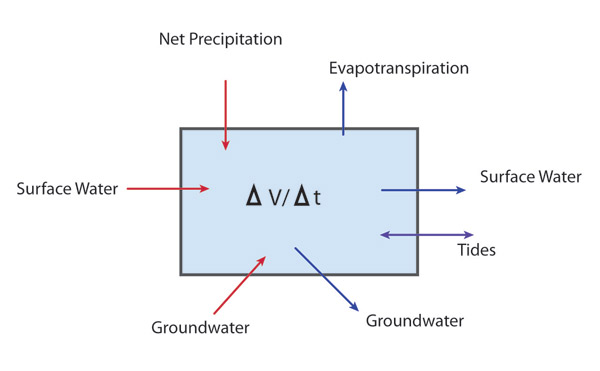
For most wetlands, the sources of inflows (e.g., precipitation, surface flow, groundwater flow, tides) and outflows (e.g., evapotranspiration, surface flow, groundwater flow, tides) change over time. As such, hydrology is rarely stable but fluctuates over time resulting in pulsing hydroperiods. Hydrologic pulses can alter productivity along a flooding gradient by altering the extent of flood subsidies and stresses in a wetland (Figure 2). When subsidies are high but stress is relatively low, pulses can promote productivity by introducing water, sediments, and nutrients while also removing waste materials and toxins.
Flooding can affect the physiochemistry of wetlands in various ways. Water can introduce or remove sediment, salt, nutrients or other materials from wetlands, thereby influencing its soil and water chemistry. Hydrology also influences the structure and function of wetland ecosystems through its influence on species richness, productivity, rates of organic matter accumulation, and nutrient cycling. Hydrology may restrict species richness in areas subject to long-term flooding while enhancing it in areas with variable or pulsing hydroperiods. Similarly, productivity is typically lower in permanently flooded, stagnant wetlands, or in drained wetlands than in slow-flowing or seasonally flooded wetlands (Conner & Day 1982). The anaerobic conditions created under these inundated or flooded conditions often limit decomposition rates, thereby promoting organic matter accumulation in soils, and can alter reduction-oxidation reactions controlling nutrient transformations in wetland soils.
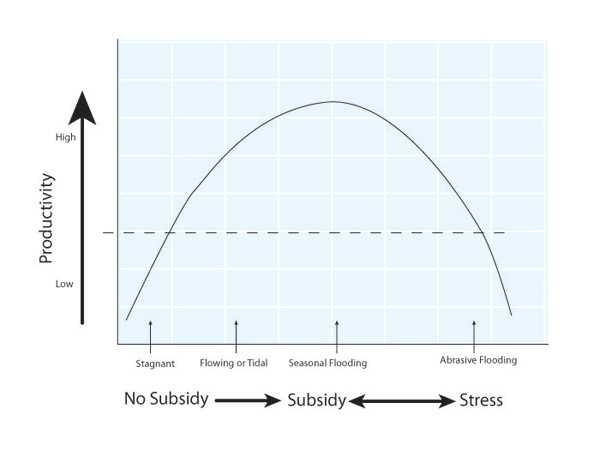
Oxygen Availability
The inundation or saturation of wetland soils by water leads to the formation of anaerobic conditions as oxygen is depleted faster than it can be replaced by diffusion. The rate of oxygen loss in flooded soils can vary depending on other soil conditions, such as temperature and rates of microbial respiration. In most wetlands, small, oxidized layers of soils may persist on the surface or around the roots of vascular plants, but generally, anaerobic, or reduced, conditions prevail.
The prevalence of anaerobic conditions in wetlands has a tremendous impact on their biogeochemistry, with important implications for carbon, nitrogen, phosphorus, iron, manganese, and sulfur transformations. Wetlands can function as sources, sinks, or transformers of these materials, depending on inflows, outflows, and internal cycling rates. One of the most important biogeochemical cycles in wetlands is the nitrogen cycle, and while the potential transformations are not unique to wetlands, the dominance of anaerobic transformations does set wetlands apart from other ecosystems. One such anaerobic transformation is denitrification, in which nitrate is lost to the atmosphere via conversion to nitrogen gas or nitrous oxide by bacteria (Mitsch & Gosselink 2007). In many wetlands, nutrient availability is dramatically altered by agriculture or other practices that increase nutrient loading, contributing to changes in ecosystem structure and function. Through processes like denitrification and plant uptake, wetlands can help remove some of this excess nitrogen introduced to wetland and aquatic ecosystems.
Wetland Communities and Ecosystems
Because of the predominance of water and anaerobic conditions in wetlands, the organisms living there, especially rooted plants, often exhibit remarkable adaptations to deal with the stresses imposed by flooding. These adaptations, including pressurized gas flow (Figure 3), creation of oxidized root zones, and anaerobic respiration, allow wetland plants to remain productive under otherwise stressful conditions, making wetlands among the most productive ecosystems in the world (Whittaker & Likens 1973). This high primary production, in turn, supports high rates of secondary production, rates that can exceed those of terrestrial ecosystems (Turner 1977).
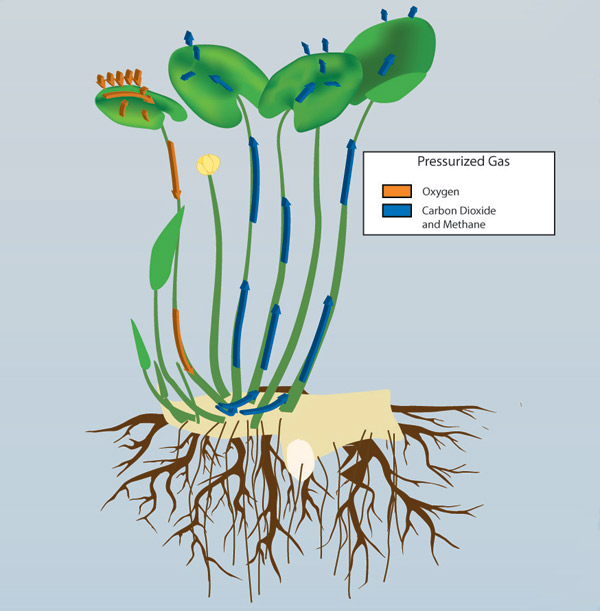
Wetlands exist along soil-moisture gradients, with wetter soils at lower elevations and drier soils at higher elevations. Wetland plant communities develop in response to this environmental gradient based primarily on their individual abilities to tolerate flooding and anaerobic soils but also in response to biotic interactions with other species. Establishment of plant species along an environmental gradient can contribute to sharp plant zonation patterns, as can be seen in coastal wetlands where species separate out along an elevation gradient in response to differences in flooding and salinity (Figure 4).
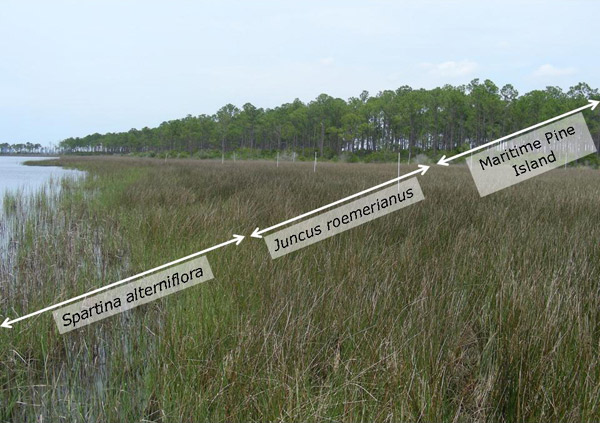
The development of these productive and often diverse plant communities fuels complex food webs that not only sustain microbial communities through large inputs of detritus to wetland soils but also support diverse communities of animals that utilize wetlands for part or all of their lives (Figure 5). Detritivores, such as shredding insects and crayfish, can utilize dead plant material as their primary energy source, while others (e.g., marsh periwinkle snails) help process organic matter for subsequent use by other organisms. Herbivory of algae by invertebrates and small fish and of plant biomass by some invertebrates, birds, and mammals (e.g., grasshoppers, geese and muskrats) is a significant energy source for primary consumers in many wetlands. Secondary production by these primary consumers supports higher trophic levels, including predatory insects, fishes, reptiles, amphibians, birds, and mammals.
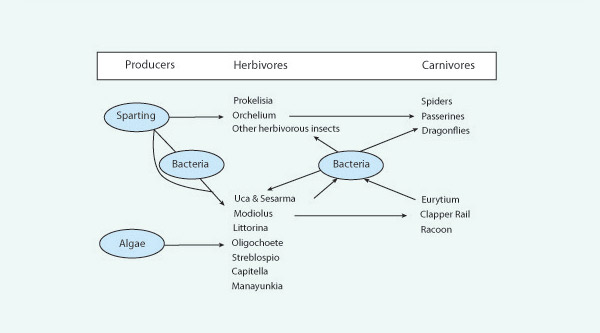
As awareness of wetland ecosystem services and values has increased, wetland ecological research also has increased. Wetland ecologists examine interactions between species and their environment, recognizing the important role that hydrology plays in shaping the physicochemical environment and biological communities in wetlands. Within that framework, ecologists can examine a near-endless array of ecological topics, from the physiology of species coping with flooding stress and anoxia to species interactions, to the impacts of and feedbacks to global climate change. The diversity of wetland types, the biodiversity they support, and the numerous functions they provide make wetlands an exciting and rewarding arena in which to explore fundamental ecological questions. And it is this science that informs efforts to manage, restore, and conserve the wetlands of the world.
References and Recommended Reading
Conner, W. H. & Day, J. W. "The ecology of forested wetlands in the southeastern United States." In Wetlands: Ecology and Management, eds. B. Gopal, et al. (Jaipur, India: National Institute of Ecology and International Scientific Publications, 1982): 69–87.
Costanza, R. W. et al. The value of the world's ecosystem services and natural capital. Nature 387, 253–260.
Cowardin, L. M. et al. Classification of Wetlands and Deepwater Habitats of the United States. FWS/OBS-79/31, Washington, DC: US Fish and Wildlife Service, 1979.
Dacey, J. W. H. Pressurized ventilation in the yellow waterlily. Ecology 62, 1137–1147 (1981).
Finlayson, M. & Moser, M. Wetlands. Oxford, UK: International Waterfowl and Wetlands Research Bureau and Facts on File, 1991.
Mitsch, W. J. & Gosselink J. G. Wetlands. Hoboken, NJ: John Wiley & Sons, 2007.
National Research Council (NRC). Wetlands: Characteristics and Boundaries. Washington, DC: National Academy Press, 1995.
National Resources Conservation Service (NRCS). Field Indicators of Hydric Soils in the United States, v. 4.0. Edited by G. W. Gurt et al. Ft. Worth, TX: USDA, NRCS, 1998.
Odum, W. E. et al. Nature's pulsing paradigm. Estuaries 18, 547–555 (1995).
Teal, J. M. Energy flow in the salt marsh ecosystem of Georgia. Ecology 43, 614–624 (1962).
Turner, R. E. Intertidal vegetation and commercial yields of penaeid shrimp. Transactions of the American Fisheries Society 106, 411–416 (1977).
United States Environmental Protection Agency (USEPA). America's Wetlands: Our Vital Link Between Land and Water. Washington, DC: Office of Water, Office of Wetlands, Oceans, and Watersheds, 1995.
Whittaker, R. H. & Likens, G. E. "Carbon in the biota." In Carbon in the Biosphere, eds. G. M. Woodwell & E. R. Peacan (Springfield, VA: National Technical Information Service, 1973): 281–302.































